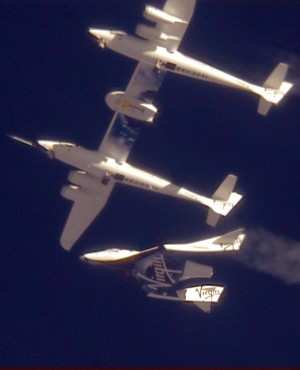First In-Flight Test Of Spacecraft's Tail Section In Its
Near-Vertical Configuration
Early on Wednesday morning, in the skies above Mojave Air and
Spaceport CA, SpaceShipTwo demonstrated its unique reentry
‘feather’ configuration for the first time. This test
flight, the third in less than two weeks, marks another major
milestone on the path to powered test flights and commercial
operations.

Photo By Clay Observatory
SpaceShipTwo (SS2), named VSS Enterprise, has now flown solo
seven times since its public roll-out in December 2009 and since
the completion of its ground and captive -carry test program.
This latest flight saw a 0643 PDT runway take off for VSS
Enterprise, attached to its WhiteKnightTwo (WK2) carrier aircraft,
VMS Eve. At the controls of the of the spaceship were Scaled
Composites’ test pilots Pete Siebold and Clint Nichols whilst
Mark Stucky, Brian Maisler and Brandon Inks crewed the purpose
built, all composite, twin fuselage WK2.
After a 45 minute climb to the desired altitude of 51,500 feet,
SS2 was released cleanly from VMS Eve and established a stable
glide profile before deploying, for the first time, its re-entry or
“feathered” configuration by rotating the tail section
of the vehicle upwards to a 65 degree angle to the fuselage. It
remained in this configuration with the vehicle’s body at a
level pitch for approximately 1 minute and 15 seconds while
descending, almost vertically, at around 15,500 FPM, slowed by the
powerful shuttlecock-like drag created by the raised tail section.
At around 33,500 feet the pilots reconfigured the spaceship to its
normal glide mode and executed a smooth runway touch down,
approximately 11 minutes and 5 seconds after its release from VMS
Eve.

Previous Test Flight
All objectives for the flight were met
and detailed flight data is now being analysed by the engineers at
Scaled Composites, designers and builders of Virgin
Galactic’s sub-orbital spacecraft.
“This morning’s spectacular flight by VSS Enterprise
was its third in 12 days, reinforcing the fast turnaround and
frequent flight-rate potential of Virgin Galactic’s new
vehicles," said George Whitesides, CEO and President of Virgin
Galactic. "We have also shown this morning that the unique
feathering re-entry mechanism, probably the single most important
safety innovation within the whole system, works perfectly. This is
yet another important milestone successfully passed for Virgin
Galactic, and brings us ever closer to the start of commercial
operations. Credit is due to the whole Scaled team, whose
meticulous planning and great skill are changing the course of
history.”
“In all test flight programs, after the training, planning
and rehearsing, there comes the moment when you have to go up there
and fly it for real," said Pete Siebold, who along with Clint
Nichols piloted the spaceship. "This morning’s flight was a
test pilot’s dream. The spaceship is a joy to fly and the
feathered descent portion added a new, unusual but wonderful
dynamic to the ride. The fact that it all went to plan, that there
were no surprises and that we brought VSS Enterprise back to Mojave
safe and sound is a great testament to the whole team.”

Previous Glide Flight
Perhaps the most innovative safety feature employed by
SpaceshipOne and now SpaceShipTwo is the unique way it returns into
the dense atmosphere from the fringe of space. This part of space
flight has always been considered as one of the most technically
challenging and dangerous, and Burt Rutan was determined to find a
failsafe solution which remained true to Scaled Composite’s
philosophy of safety through simplicity. His inspiration for what
is known as the feathered re-entry was the humble shuttlecock,
which like SpaceShipTwo relies on aerodynamic design and laws of
physics to control speed and attitude.
Once out of the atmosphere the entire tail structure of the
spaceship can be rotated upwards to about 65 degrees. The feathered
configuration allows an automatic control of attitude with the
fuselage parallel to the horizon. This creates very high drag as
the spacecraft descends through the upper regions of the
atmosphere. The feather configuration is also highly stable,
effectively giving the pilot a hands-free re-entry capability,
something that has not been possible on spacecraft before, without
resorting to computer controlled fly-by-wire systems. The
combination of high drag and low weight (due to the very light
materials used to construct the vehicle) mean that the skin
temperature during re-entry stays very low compared to previous
manned spacecraft and thermal protection systems such as heat
shields or tiles are not needed. During a full sub-orbital
spaceflight, at around 70,000ft following re-entry, the feather
lowers to its original configuration and the spaceship becomes a
glider for the flight back to the spaceport runway.
 ANN's Daily Aero-Linx (04.16.24)
ANN's Daily Aero-Linx (04.16.24) Aero-News: Quote of the Day (04.16.24)
Aero-News: Quote of the Day (04.16.24) Airborne 04.10.24: SnF24!, A50 Heritage Reveal, HeliCycle!, Montaer MC-01
Airborne 04.10.24: SnF24!, A50 Heritage Reveal, HeliCycle!, Montaer MC-01 Airborne 04.12.24: SnF24!, G100UL Is Here, Holy Micro, Plane Tags
Airborne 04.12.24: SnF24!, G100UL Is Here, Holy Micro, Plane Tags Airborne-Flight Training 04.17.24: Feds Need Controllers, Spirit Delay, Redbird
Airborne-Flight Training 04.17.24: Feds Need Controllers, Spirit Delay, Redbird





